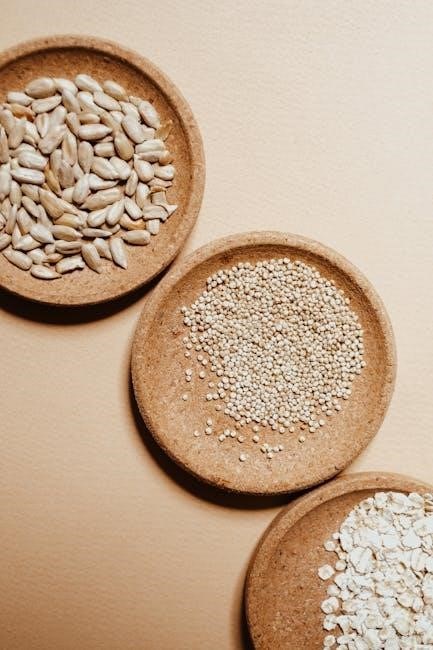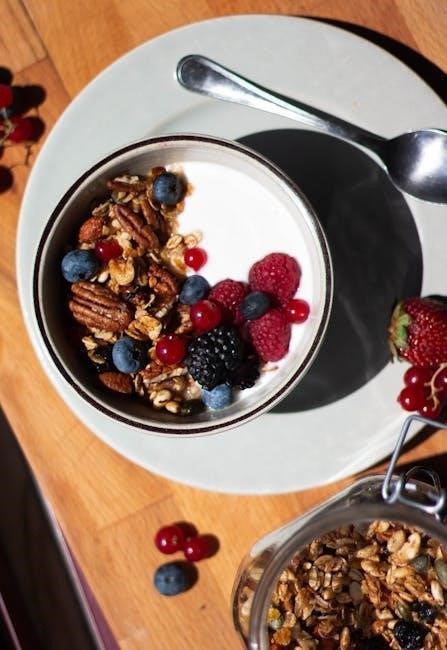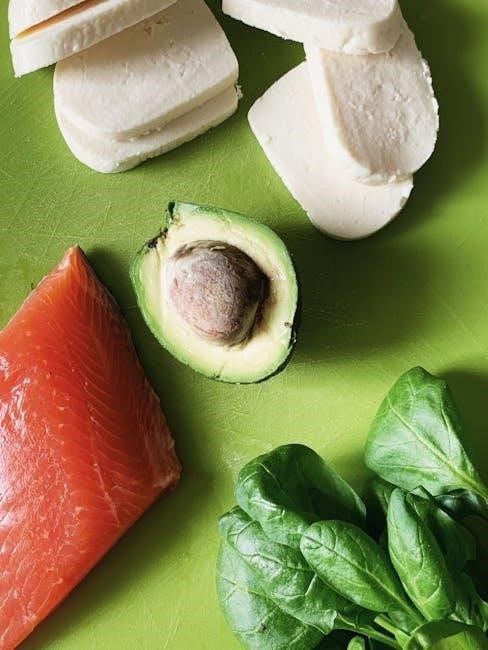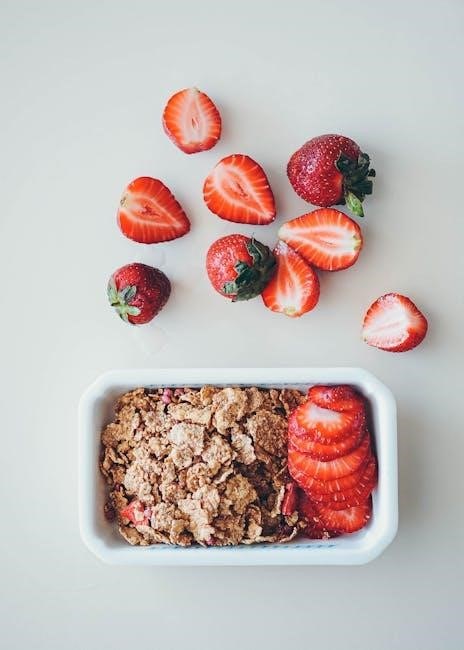A low-fat diet focuses on reducing dietary fat intake, often recommended for weight management, heart health, and managing certain medical conditions. It emphasizes whole, nutrient-rich foods.
What is a Low-Fat Diet?
A low-fat diet is a dietary approach that restricts fat intake, focusing on lean proteins, whole grains, fruits, and vegetables. It limits high-fat foods like red meats and full-fat dairy, emphasizing nutrient-rich options. This diet often aids in weight management and improves heart health by reducing saturated fats and cholesterol consumption, aligning with medical recommendations for certain conditions.
Why Choose a Low-Fat Diet?
Choosing a low-fat diet can aid in weight management and improve cardiovascular health by reducing saturated fats and cholesterol. It may also lower the risk of chronic diseases like diabetes and certain cancers. This dietary approach is often recommended for individuals with specific health conditions or those seeking a balanced, nutrient-rich eating plan for overall well-being and longevity.

Benefits of a Low-Fat Diet
A low-fat diet supports weight management, enhances cardiovascular health, and reduces the risk of chronic diseases. It promotes a balanced lifestyle and improves overall well-being effectively.
Weight Management
Low-fat diets aid in weight management by reducing calorie intake through lower-fat foods. They emphasize whole grains, fruits, and vegetables, which are naturally low in fat and high in fiber, promoting satiety and supporting sustainable weight loss while maintaining essential nutrients for overall health and well-being.
Cardiovascular Health
A low-fat diet supports cardiovascular health by reducing saturated fat intake, which helps lower cholesterol levels and prevent plaque buildup in arteries. This can decrease blood pressure and minimize the risk of heart disease, strokes, and other cardiovascular conditions, promoting overall heart health and well-being.
Reduced Risk of Chronic Diseases
A low-fat diet is associated with a lower risk of chronic diseases, such as diabetes and certain cancers. By limiting saturated fats and emphasizing plant-based foods, it helps maintain a healthy weight and improves insulin sensitivity, reducing the likelihood of developing these conditions over time.

Risks and Considerations
A low-fat diet may lead to nutrient deficiencies if not planned properly. Fat-soluble vitamins (A, D, E, K) require dietary fat for absorption, and overly restrictive diets can cause dissatisfaction.
Nutrient Deficiencies
A low-fat diet may result in insufficient intake of fat-soluble vitamins (A, D, E, K) and essential fatty acids, crucial for brain health and hormone production. Additionally, overly restricting fat can lead to inadequate calorie intake, potentially causing fatigue and nutrient deficiencies if not properly balanced with nutrient-dense foods.
Potential Negative Impact on Health
Excessive fat restriction may negatively impact health by reducing HDL (good cholesterol) levels and increasing triglycerides, potentially harming cardiovascular health. Additionally, low-fat diets can sometimes lead to higher carbohydrate consumption, possibly contributing to insulin resistance and weight gain if sugars and refined carbs are overconsumed.

Food Groups in a Low-Fat Diet
A low-fat diet includes lean meats, poultry, fish, and plant-based proteins, along with whole grains, fruits, and vegetables. Choose low-fat dairy and avoid processed, high-fat foods.
Meat, Poultry, and Fish
Choose lean meats like chicken breast, turkey, or lean beef. Opt for poultry without skin and fish rich in omega-3s, like salmon. Avoid processed meats and high-fat cuts. Trim visible fat and cook using low-fat methods like baking or grilling. Portion control is essential, and limit sauces or seasonings high in fat.
Dairy Products
Opt for skim milk, nonfat yogurt, and low-fat cheeses like cottage cheese or ricotta. Avoid whole milk, cream, and high-fat cheeses. Choose nonfat sour cream and select dairy products with minimal added sugars. These options provide essential nutrients while keeping fat content low, supporting overall health and weight management.
Grains and Cereals
Choose whole grains like oats, brown rice, and whole-wheat bread for their fiber and nutrients. Opt for low-fat breakfast cereals and avoid fried or high-fat grain products. Grains provide sustained energy and are naturally low in fat when prepared without added oils or butter, making them a healthy staple in a low-fat diet.
Fruits and Vegetables
Fruits and vegetables are naturally low in fat and rich in essential vitamins, minerals, and antioxidants. They support heart health, digestion, and weight management. Include a variety of colorful options like berries, leafy greens, and citrus fruits in your diet to enhance nutrient intake and overall well-being.
Meal Planning and Grocery Shopping Tips
Plan meals around lean proteins, whole grains, and vibrant vegetables. Shop the perimeter of the grocery store to avoid processed, high-fat items.
Creating Balanced Meals
A balanced meal includes lean proteins like poultry or fish, whole grains, and a variety of colorful vegetables. Incorporate legumes for fiber and nutrients. Healthy fats, such as avocado or olive oil, can be added in moderation for flavor and nutrition.
Reading Food Labels
When following a low-fat diet, check food labels for fat content per serving. Opt for products with less than 3g of fat per serving. Avoid hidden fats in processed foods and choose nonfat or low-fat versions of dairy and snacks. Prioritize items rich in fiber, protein, and essential nutrients to ensure a balanced intake.

Snacks and Desserts on a Low-Fat Diet
Focus on nutrient-rich snacks like fruits, vegetables, and lean proteins. For desserts, choose low-fat yogurt, sorbet, or nonfat ice cream to satisfy cravings without excess fat.
Healthy Snack Options
Fresh fruits, vegetables, and nuts in moderation are excellent low-fat snacks. Opt for whole grains, lean proteins like hard-boiled eggs, or turkey slices. Avoid processed snacks and choose air-popped popcorn or low-fat yogurt for satisfying crunch and flavor. Always read labels to ensure snacks meet your dietary goals and maintain nutrient balance.
Low-Fat Dessert Ideas
Enjoy guilt-free treats with low-fat options like fresh fruit sorbet, baked apples with cinnamon, or fruit parfaits. Nonfat yogurt with vanilla and berries makes a sweet delight. Opt for dark chocolate in moderation or try poached pears for a light, satisfying dessert that aligns with your dietary goals.

Comparing Low-Fat and Low-Carb Diets
Low-fat and low-carb diets are popular choices. Low-fat focuses on reducing dietary fat, emphasizing whole grains and fruits, benefiting heart health. Low-carb restricts sugars and starches, promoting fat and protein intake for weight loss and blood sugar management. Research suggests low-fat may support longevity better.
Key Differences
Low-fat diets focus on reducing fat intake, emphasizing whole grains, fruits, and lean proteins, while low-carb diets restrict carbohydrates, promoting higher protein and fat consumption. Low-fat diets aim to improve heart health and support longevity, whereas low-carb diets often target weight loss and blood sugar management. The choice depends on individual goals and health needs.
Which Diet is Better for Longevity?
Research suggests low-fat diets may support longevity by reducing chronic disease risks, such as heart disease and diabetes. They emphasize whole, nutrient-rich foods, promoting overall health. While low-carb diets focus on weight loss, low-fat diets align with long-term health benefits, making them a potentially better choice for extending lifespan and improving quality of life.

Tips for Maintaining a Low-Fat Diet
Use non-stick pans, herbs, and spices for flavor instead of added fats. Opt for grilling, baking, or steaming to avoid frying; Choose low-fat cooking methods consistently.
Cooking Without Added Fats
Cooking without added fats is achievable by using non-stick pans, grilling, baking, or steaming. Marinate meats and vegetables with herbs and spices for flavor. Trim visible fat from meats and opt for broth or water instead of oil. These methods ensure delicious meals while keeping fat intake low and maintaining nutritional value effectively.
Staying Motivated
Staying motivated on a low-fat diet requires setting realistic goals and celebrating small achievements. Track your progress, focus on health benefits, and remind yourself of your long-term objectives. Surround yourself with support, and reward yourself with non-food treats. Embrace the journey, and stay positive by highlighting improvements in energy and overall well-being along the way.
A low-fat diet offers numerous health benefits, including improved heart health and weight management. Balancing nutrition and lifestyle ensures long-term success and overall well-being.
Final Thoughts
A low-fat diet can be an effective approach for improving health when balanced with essential nutrients. It’s important to avoid extremes and focus on whole, nutrient-dense foods. Long-term success requires commitment and mindful eating. Consulting with a healthcare provider ensures a personalized plan tailored to specific needs and goals for sustainable well-being.
Resources for Further Reading
For more detailed guidance, download a Low-Fat Diet PDF, which often includes food lists, meal plans, and tips. Clinical guidelines and nutrition websites provide evidence-based advice. Check resources from health organizations or academic journals for comprehensive insights. These materials help tailor the diet to individual needs and preferences, ensuring a well-rounded approach to healthy eating.

